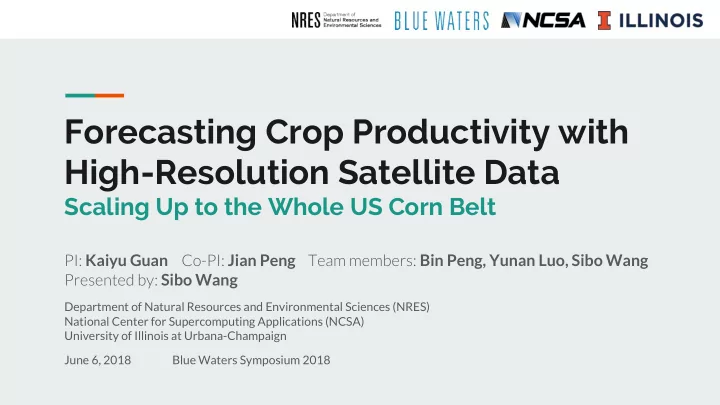

Forecasting Crop Productivity with High-Resolution Satellite Data Scaling Up to the Whole US Corn Belt PI: Kaiyu Guan Co-PI: Jian Peng Team members: Bin Peng, Yunan Luo, Sibo Wang Presented by: Sibo Wang Department of Natural Resources and Environmental Sciences (NRES) National Center for Supercomputing Applications (NCSA) University of Illinois at Urbana-Champaign June 6, 2018 Blue Waters Symposium 2018
Objective Improve our predicting skills for regional/global crop yield by integrating advanced remote sensing observations and process-based modeling . 2
Satellite Remote Sensing for Agriculture Wide coverage provides large data volume ● “Big data” ○ Data with high resolution in both space and time is needed ○ Uniform, standardized metric ● Overcomes regional limitations ○ Allows large-scale (eg. planetary) application ○ 3
US Corn Belt Maize (corn) is the most important staple food and feed crop in the ● world (according to the total production). The US Midwest Corn Belt produces over 45% of global maize ● production. 4
Why Blue Waters High-resolution satellite images are huge ● Blue Waters provides great computation power and storage capacity ● Allows scaling up at fine resolution ○ PC. Cray Inc. 5
Outline Part I: High-Resolution Satellite Image Processing STAIR: fusing datasets at different resolution and frequency ● PlanetScope: making use of high-resolution CubeSAT data ● Part II: Process-Based Crop Modeling CLM-APSIM: improving maize growth process models ● 6
High-Resolution Satellite Image Processing STAIR Fusion ● CubeSAT Processing ● 7 PC. NASA Earth Observatory https://earthobservatory.nasa.gov/IOTD/view.php?id=5772
The Dilemma Satellite platforms face trade-offs between spatial resolution and ● temporal frequency High resolution and high revisiting frequency can’t be achieved by the same sensor ○ Agricultural analysis requires continuous time series data at fine resolution ○ 8
Satellite Platforms CubeSAT , Planet Lab High 3.125m PlanetScope Resolution Sentinel 2 , ESA 10m European Space Agency Landsat , USGS 30m US Geological Survey MODIS , NASA 500m Moderate Resolution Imaging Spectroradiometer 9
Satellite Platforms MODIS , NASA High daily Moderate Resolution Imaging Spectroradiometer Frequency CubeSAT , Planet Lab every ~3 days PlanetScope Landsat , USGS ~ weekly US Geological Survey Sentinel 2 , ESA every ~2 weeks European Space Agency 10
MODIS (500m) Landsat (30m) Planet CubeSat (3m) Sentinel 2 (10m) 11
STAIR Fusion A generic and fully automated method for fusing multi-spectral ● satellite data Achieves a high-resolution , high-frequency , cloud-free , gap-free ● composite dataset Luo, Y., Guan, K., Peng, J. 2018. “STAIR: A generic and fully-automated method to fuse multiple sources of optical satellite data to generate a high-resolution, daily and cloud-/gap-free surface reflectance product.” Remote Sensing of Environment , 214. 12
Additional Challenges Gaps due to clouds ● Sample Landsat 7 image with Landsat 7 Scan Line Corrector failure ● strips after SLC malfunction Inter-tile consistency ● Sample Landsat 5 image with clouds and cloud shadows 13
https://www.youtube.com/wat ch?v=ISZ7MZrG8nM 14
PlanetScope CubeSAT Owned by private company Planet Labs ● A fleet of 175+ small CubeSAT satellite platforms ● High resolution ( 3m ) ● PC. Planet Labs Also has more potential issues ● Inconsistency in spectral response among platforms ○ Quality assessment (mainly cloud detection) ○ Quality of surface reflectance product ○ Cost ○ 15
A Complete Pipeline Goal: ● Generate a more usable PlanetScope-derived dataset ready for agricultural analyses ○ What we have: ● Fusion product with reliable time series (from MODIS) and 30m-resolution spatial ○ details (from Landsat) Large volume of raw PlanetScope data ○ Workflow: ● Fusion-based spectral correction ○ Fusion-based outlier/cloud detection ○ Time series smoothing ○ 16
17
Atmospheric Correction 18
Land-Cover-Specific Outlier Detection 19
Spectral Correction 20
Raw Planet Lab Data Processed Planet Lab Data 21
Process-Based Modeling CLM-APSIM ● Public Domain
CLM-APSIM Agronomy crop models (eg. Agricultural Production System Simulator (APSIM), Keating et al., ● 2003; Holzworth et al., 2014 ) simulate field-level crop growth. Phenology stages are considered. Earth system models (ELMs) such as the Community Land Model (CLM, Oleson et al., 2013; ● Lawrence et al., 2011 ) numerically and explicitly solve surface water, energy and carbon balances, but are much simpler and usually do not consider phenology-stage-dependent stresses. CLM-APSIM integrates the strengths of both families of crop models. ● Improved the representation of maize phenological development. ○ Corrected the deficiencies in carbon allocation scheme. ○ Peng, B. et al., 2018. “Improving maize growth processes in the community land model: Implementation and Evaluation.” Agricultural and Forest Meteorology , 250-251 (2018). 23
24
← harvest index at the three sites ↓ biomass pools ↑ canopy height 25
Crop Modeling: Moving Forward 1) Simulate the whole US Corn belt 2) Explicit calibration at the grid level 3) Ingest satellite data for data assimilation 4) Real-time forecasting of crop yield 26
Questions? 27
Recommend
More recommend